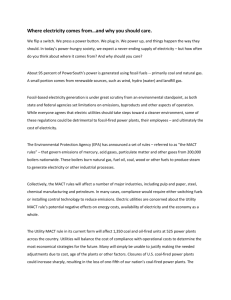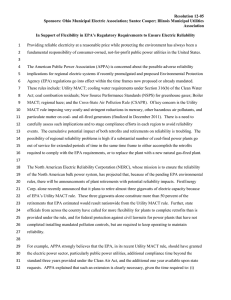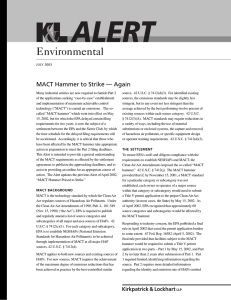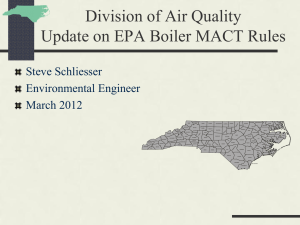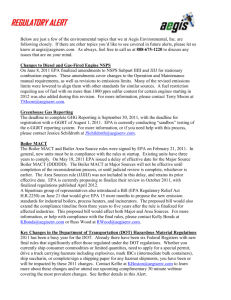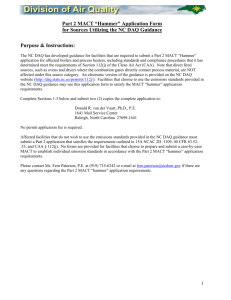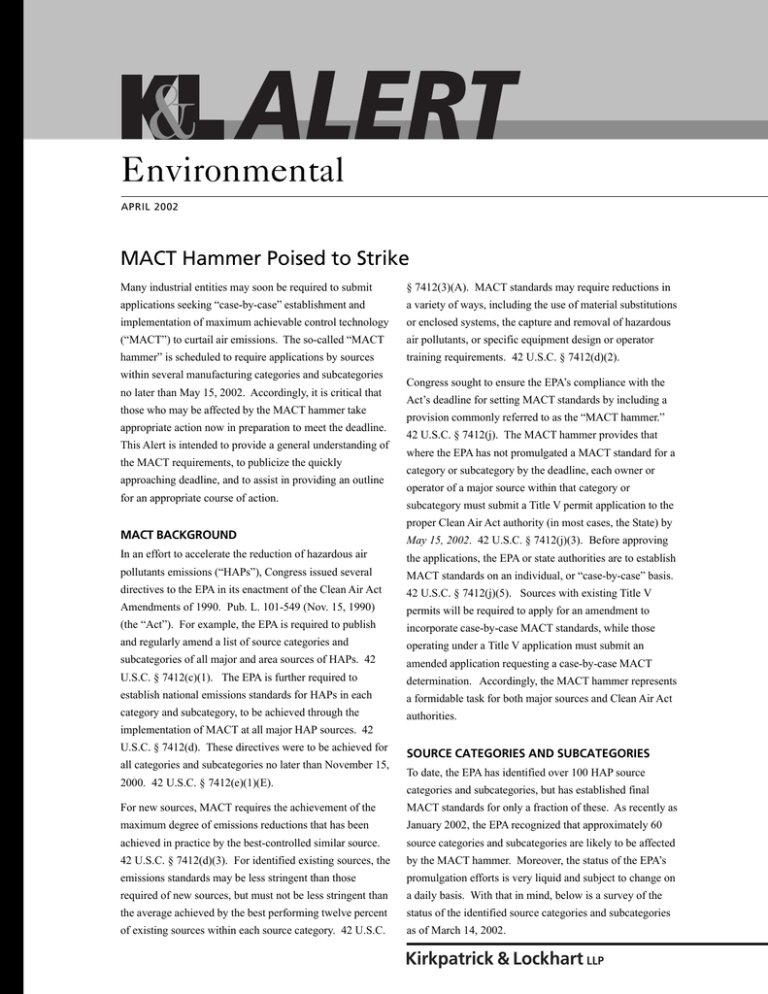
Environmental
APRIL 2002
MACT Hammer Poised to Strike
Many industrial entities may soon be required to submit
§ 7412(3)(A). MACT standards may require reductions in
applications seeking “case-by-case” establishment and
a variety of ways, including the use of material substitutions
implementation of maximum achievable control technology
or enclosed systems, the capture and removal of hazardous
(“MACT”) to curtail air emissions. The so-called “MACT
air pollutants, or specific equipment design or operator
hammer” is scheduled to require applications by sources
training requirements. 42 U.S.C. § 7412(d)(2).
within several manufacturing categories and subcategories
no later than May 15, 2002. Accordingly, it is critical that
those who may be affected by the MACT hammer take
appropriate action now in preparation to meet the deadline.
This Alert is intended to provide a general understanding of
the MACT requirements, to publicize the quickly
approaching deadline, and to assist in providing an outline
for an appropriate course of action.
Congress sought to ensure the EPA’s compliance with the
Act’s deadline for setting MACT standards by including a
provision commonly referred to as the “MACT hammer.”
42 U.S.C. § 7412(j). The MACT hammer provides that
where the EPA has not promulgated a MACT standard for a
category or subcategory by the deadline, each owner or
operator of a major source within that category or
subcategory must submit a Title V permit application to the
proper Clean Air Act authority (in most cases, the State) by
MACT BACKGROUND
May 15, 2002. 42 U.S.C. § 7412(j)(3). Before approving
In an effort to accelerate the reduction of hazardous air
the applications, the EPA or state authorities are to establish
pollutants emissions (“HAPs”), Congress issued several
MACT standards on an individual, or “case-by-case” basis.
directives to the EPA in its enactment of the Clean Air Act
42 U.S.C. § 7412(j)(5). Sources with existing Title V
Amendments of 1990. Pub. L. 101-549 (Nov. 15, 1990)
permits will be required to apply for an amendment to
(the “Act”). For example, the EPA is required to publish
incorporate case-by-case MACT standards, while those
and regularly amend a list of source categories and
operating under a Title V application must submit an
subcategories of all major and area sources of HAPs. 42
amended application requesting a case-by-case MACT
U.S.C. § 7412(c)(1). The EPA is further required to
determination. Accordingly, the MACT hammer represents
establish national emissions standards for HAPs in each
a formidable task for both major sources and Clean Air Act
category and subcategory, to be achieved through the
authorities.
implementation of MACT at all major HAP sources. 42
U.S.C. § 7412(d). These directives were to be achieved for
all categories and subcategories no later than November 15,
2000. 42 U.S.C. § 7412(e)(1)(E).
SOURCE CATEGORIES AND SUBCATEGORIES
To date, the EPA has identified over 100 HAP source
categories and subcategories, but has established final
For new sources, MACT requires the achievement of the
MACT standards for only a fraction of these. As recently as
maximum degree of emissions reductions that has been
January 2002, the EPA recognized that approximately 60
achieved in practice by the best-controlled similar source.
source categories and subcategories are likely to be affected
42 U.S.C. § 7412(d)(3). For identified existing sources, the
by the MACT hammer. Moreover, the status of the EPA’s
emissions standards may be less stringent than those
promulgation efforts is very liquid and subject to change on
required of new sources, but must not be less stringent than
a daily basis. With that in mind, below is a survey of the
the average achieved by the best performing twelve percent
status of the identified source categories and subcategories
of existing sources within each source category. 42 U.S.C.
as of March 14, 2002.
Kirkpatrick & Lockhart LLP
MACT PROPOSED – NOT FINAL
ASPHALT ROOFING & PROCESSING
Asphalt Roofing
Asphalt Processing
CELLULOSE PRODUCTION MFG.
Carboxymethylcellulose Production
Cellulose Ethers Production
Cellulose Food Casing Manufacturing
Cellophane Production
Methylcellulose Production
Rayon Production
COKE OVENS: PUSHING, QUENCHING &
BATTERY STACKS
FLEXIBLE POLYURETHANE FOAM
FABRICATION OPERATION
FRICTION PRODUCTS MANUFACTURING
GENERIC MACT:
Carbon Black Production
Cyanide Chemicals Manufacturing
Ethylene Processes
Spandex Production
HYDROCHLORIC ACID PRODUCTION
INDUSTRY/FUMED SILICA PRODUCTION
INTEGRATED IRON & STEEL
LARGE APPLIANCE (surface coating)
METAL COIL (surface coating) INDUSTRY
MUNICIPAL SOLID WASTE LANDFILLS
PAPER & OTHER WEB COATING (surface coating)
PETROLEUM REFINERIES - Catalytic Cracking,
Catalytic Reforming & Sulfur Plant Units
POLYVINYL CHLORIDE & COPOLYMERS
PRODUCTION
PRIMARY COPPER
REINFORCED PLASTIC COMPOSITES
PRODUCTION
ENGINE TEST FACILITIES
(Combined with the Rocket Testing Facilities rule)
FABRIC PRINTING, COATING, & DYEING
INDUSTRIAL, COMMERCIAL AND
INSTITUTIONAL BOILERS & PROCESS HEATERS
IRON FOUNDRIES
LIGHTWEIGHT AGGREGATE (to be delisted)
LIME MANUFACTURING
MERCURY CELL CHLOR-ALKALI PLANTS
(formerly Chlorine Production)
METAL CAN (surface coating)
METAL FURNITURE (surface coating)
MISCELLANEOUS METAL PARTS & PRODUCTS
(surface coating)
Asphalt/Coal Tar Application to Metal Pipes
MISCELLANEOUS ORGANIC CHEMICAL
PRODUCTION & PROCESSES
Alkyd Resins Production
Ammonium Sulfate Production
Benzyltrimethylammonium Chloride Production
Carbonyl Sulfide Production
Chelating Agents Production
Chlorinated Paraffins Production
Ethyllidene Norbomene Production
Explosives Production
Hydrazine Production
Maleic Anhydride Copolymers Production
Manufacture of Paints, Coatings, & Adhesives
OBPA/1,3-diisocyanate Production
Photographic Chemicals Production
Phthalate Plasticizers Production
Polyester Resins Production
ORGANIC LIQUIDS DISTRIBUTION
(non-gasoline)
PAINT STRIPPING OPERATIONS
TIRE MANUFACTURING
PLASTIC PARTS (surface coating)
WET FORMED FIBERGLASS MAT PRODUCTION
PLYWOOD and COMPOSITE WOOD PRODUCTS
(formerly Plywood and Particle Board Manufacturing)
MACT NOT YET PROPOSED
ASPHALT/COAL TAR APPLICATION METAL PIPES
PRIMARY MAGNESIUM REFINING
RECIP. INTERNAL COMBUSTION ENGINES
(NESHAP/NSPS)
AUTO & LIGHT DUTY TRUCK MFG.
(surface coating)
REFRACTORY PRODUCTS MANUFACTURING
(formerly Chromium Refractories)
BRICK, STRUCTURAL CLAY PRODUCTS & CLAY
CERAMICS MANUFACTURING
SEMICONDUCTOR PRODUCTION
CLAY MINERALS PROCESSING
(To be addressed in the Brick, Structural Clay Products,
and Clay Ceramics Manufacturing rule)
COMBUSTION TURBINE
(formerly Stationary Turbines)
SEWAGE SLUDGE INCINERATORS
(to be delisted)
SITE REMEDIATION
TACONITE IRON ORE PROCESSING
WOOD BUILDING PRODUCTS (surface coating)
(formerly Flat Wood Paneling)
Source: Office of Air Quality Planning and Standards,
United States EPA, available at http://www.epa.gov/ttn/atw/eparules.html
2
KIRKPATRICK & LOCKHART LLP ENVIRONMENTAL ALERT
DETERMINING APPLICABILITY
OF MACT STANDARDS
Does the source currently hold a Title V permit, or
does it have a pending Title V application? If so, the
The EPA acknowledges that it will not have final MACT
source will not necessarily be required to submit a new
standards in place for all source categories and
Title V application. However, it is required to submit a
subcategories by the May 15, 2002 deadline. The EPA has
request for permit amendment or an amended
signed a final rule directing source categories affected by
application by the MACT hammer deadline if it meets
the MACT hammer to submit basic information to the
each of the above criteria.
Clean Air Act authority by the May 15, 2002 deadline, to
be followed by a more detailed supplemental application
“It is important to recognize that the MACT hammer
within 24 months. The EPA refers to these two sequential
applies to source categories and subcategories with no
submissions as Parts 1 and 2 of the application,
final MACT standards - where a MACT standard has been
respectively. See “National Emission Standards for
proposed, it should not be assumed that the standard will
Hazardous Air Pollutants for Source Categories: General
be final before the May 15, 2002 deadline.” Accordingly,
Provisions; and Requirements for Control Technology
potentially affected sources that have not already done so
Determinations for Major Sources in Accordance with
should undertake an applicability analysis as soon as
Clean Air Act Sections, Sections 112(g) and 112(j),”
possible in preparation for the looming deadline. The
available at http://www.epa.gov/ttn/oarpg/t3pfpr.html
MACT hammer is in motion and closing in fast.
(“Final Rule”). While the Final Rule mitigates the
immediacy of the MACT hammer to some extent, as
discussed below, potentially affected sources should begin
assessing now whether a Title V submittal will be
required.
WHAT HAPPENS NEXT: AN APPROPRIATE
COURSE OF ACTION WHEN THE MACT HAMMER IS POTENTIALLY APPLICABLE
As noted above, the Final Rule has somewhat softened the
blow of the MACT hammer by dividing the application
To determine whether the MACT hammer will require a
process into two parts – Part 1 and Part 2. Sources
submittal by May 15, 2002, owners and operators should
affected by the MACT hammer must submit Part 1 of the
consider each of the following:
MACT application to the CAA authority (in most cases,
Does the facility emit HAPs? Section 112(b) of the
Clean Air Act provides a list of HAPs, which has been
supplemented by the EPA in subsequent regulations.
42 U.S.C. § 7412(b); 40 C.F.R. § 61.01(a).
Is the facility a major source of HAPs? A facility is a
major source of HAPs if it has the potential to emit 10
the State) by the May 15, 2002 deadline. The EPA has
indicated that failure to submit a timely Part 1 application
may lead to an enforcement action. A Part 1 application
must contain the following information:
the name and physical address of the source;
a brief description of the major source and an
tons per year of any HAP, or 25 tons per year of all
identification of the relevant source category;
HAPs combined. 42 U.S.C. § 7412(a)(1).
Does the facility fall within a source category or
belonging to the relevant source category; and
subcategory with no final MACT standard? The EPA
has stated its belief taht owners and operators should
an identification of the types of emission points
an identification of any affected sources within a
facility for which a MACT determination has already
be able to reasonably determine whether a source is
been made.
within a category or subcategory with no final MACT
standard by referring to the proposed rules that have
Part 2 of the MACT application is due no later than 24
been published or, for a category or subcategory for
months after submission of Part 1, and must contain the
which no rule has yet been proposed, by referring to
following information:
the EPA’s Air Toxics Website. This, however, may not
for new sources, the anticipated day date of startup;
identification of the HAPs emitted by each affected
be as clearcut as the EPA suggests. An owner or
operator who is unsure about MACT applicability may
submit a Part 1 MACT application asking for an
source in the relevant source category and an estimated
applicability determination by the permitting authority.
total controlled and uncontrolled emission rate for each
HAP;
MARCH 2002
Kirkpatrick & Lockhart LLP
any existing Federal, State, or local limitations or
an individual MACT determination. Instead, it must only
requirements applicable to the affected source;
comply with the relevant final standards by the deadline set
identification of control technology in place for each
affected emission point;
forth therein. As noted above, the status of the rules
relating to many of the identified source categories are in a
state of flux. The EPA has indicated that while it will miss
any information relevant to establishing a MACT floor,
the May 15, 2002 deadline for a number of source
and at the option of the source owner or operator, a
categories, it is hopeful that it will have final rules in place
recommended MACT floor; and
for several others. Furthermore, of the source categories
any other information reasonably needed at the
with no final rule by the deadline and therefore requiring a
discretion of the permitting authority.
Part 1 application, several may have final rules in place
before a Part 2 application is due, and others after
Upon receipt of the Part 2 application, the CAA authority
submission of a Part 2 application, but before an individual
is responsible for determining the appropriate MACT
determination is due from the permitting authority. Thus,
standard for each individual source, unless the EPA has
frequent monitoring of the status of the relevant MACT
finalized a MACT standard for the relevant source
rule may allow a source to avoid time and expense
category in the interim.
involved in unnecessary preparation of any or all of a
While the responsibility for determining a MACT standard
MACT application.
lies with the CAA authority, an owner or operator of an
ARNNIE DODDERER
affected source has an opportunity to influence the
412.355.8255
adodderer@kl.com
individual determination by submitting the following
optional information in the Part 2 application:
KENNETH S. KOMOROSKI
recommended emission limitations for the affected
412.355.6556
kkomoroski@kl.com
source, together with support information, or
recommended design, equipment, work practice, or
BARR
Y M. HAR
TMAN
BARRY
HARTMAN
operational standard, or a combination thereof, as an
202.778.9338
bhartman@kl.com
emission limitation;
a description of the control technologies the source
intends to apply to meet an emission limitation
FOR FURTHER INFORMATION about criminal enforcement of
including technical information on the design,
environmental laws or Kirkpatrick & Lockhart’s environmental
practice, please consult the author or one of the Kirkpatrick &
Lockhart LLP office contacts listed below. You may also visit
our webpage at www.kl.com.
operation, size, estimated control efficiency, and
identification of the affected sources to which the
control technologies will apply; and
a recommended monitoring program to demonstrate
continuous compliance any MACT emissions
limitations.
Throughout the MACT application process, a source
should remain aware of the ongoing status of the MACT
Roger C. Zehntner
Stephen A. Kennedy
R. Timothy Weston
Paul W. Sweeney, Jr.
Daniel A. Casey
Anthony P. La Rocco
Warren H. Colodner
Kenneth S. Komoroski
Richard W. Hosking
Edward P. Sangster
Barry M. Hartman
Boston
Dallas
Harrisburg
Los Angeles
Miami
Newark
New York
Pittsburgh
Pittsburgh
San Francisco
Washington
617.261.3149
214.939.4917
717.231.4504
310.552.5055
305.539.3324
973.848.4014
212.536.3912
412.355.6556
412.355.8612
415.249.1028
202.778.9338
rzehntner@kl.com
skennedy@kl.com
tweston@kl.com
psweeney@kl.com
dcasey@kl.com
alarocco@kl.com
wcolodner@kl.com
kkomoroski@kl.com
rhosking@kl.com
esangster@kl.com
bhartman@kl.com
rules for its relevant source category, as its appropriate
course of action is subject to sudden change. Once a final
rule is in place, an affected source is not required to seek
®
Kirkpatrick & Lockhart LLP
Challenge us.
BOSTON
■
DALLAS
■
HARRISBURG
■
LOS ANGELES
■
MIAMI
■
NEWARK
■
NEW YORK
■
PITTSBURGH
■
SAN FRANCISCO
■
®
WASHINGTON
.........................................................................................................................................................
4
This publication/newsletter is for informational purposes and does not contain or convey legal advice. The information herein
should not be used or relied upon in regard to any particular facts or circumstances without first consulting with a lawyer.
KIRKPATRICK & LOCKHART LLP ENVIRONMENTAL ALERT
© 2002 KIRKPATRICK & LOCKHART LLP.
ALL RIGHTS RESERVED.


